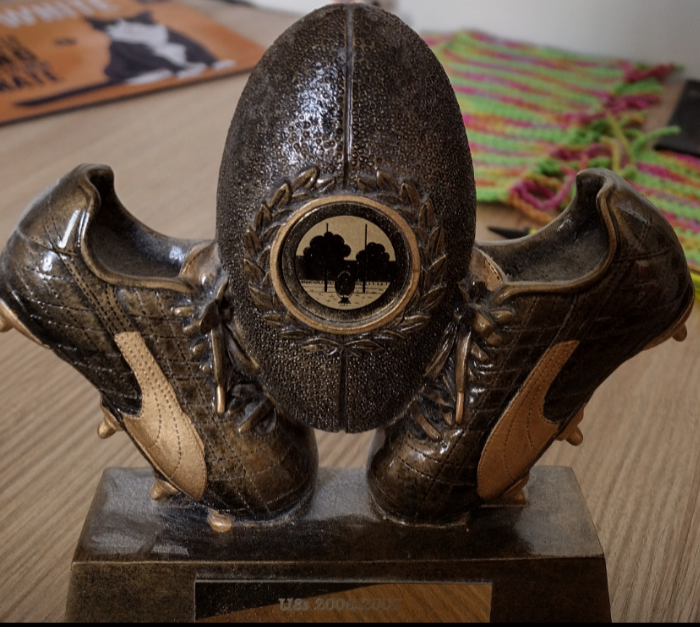What does mental fortitude look like to you? Here is my most recent example of what it means to me. ⬇️

Here I am, mid climb, during a fundraising event. People could look at this photo and potentially think nothing of it. But hear me out. This was the most difficult wall to climb out of the 5 options, as not all of the square blocks had parts to hold onto for stability. I just about had the strength in my legs to push myself up to the next block from the one here, which is roughly halfway. But leg strength wasn’t the only thing I needed here. I felt the consequences of hurling my arms up as far as they would reach to get up to the top. Having Dyspraxia means that developmentally speaking, these movements are a bigger challenge for me than most who also took part. 12 climbs later, I couldn’t be happier to have accomplished this. And to be the one to do the final climb, this was a moment of pure determination for me.
Not everything works like this though, where pure adrenaline gets you over the line. I have also taken part in other activities where I learn that building mental fortitude doesn’t happen in one circumstance alone. Having recently joined my local lawn bowls club, I’ve lost all 3 games I have played in tournaments so far. But I take pride in this. In my most recent game, I managed to get to within 1 wood in the second set of a best of 3 match of one of the best players at the club, who has played in county games and been one win away from claiming one of the best rewards in the sport. Losing doesn’t have to mean doom and gloom. Sure, in game 1, when all was going to plan and then my opponent made several great plays, I wasn’t in the greatest headspace and ultimately caved in. But it is a sport of fine margins, which has its elements of winning by luck at times. So it wasn’t the end of the world to me. But it was a time of experiencing the troughs of mental fortitude rather than the previous peaks.
Building resilience with a neurodivergent profile, like everything, takes a lot more time than for the average person. And I won’t shy away from saying that over the years, I have again, experienced the highs and lows of resilience. I put this down to masking. Because in the most heated moments, when emotions rise to the surface, you ultimately don’t want the worst of it to show.
I have completed a 24 mile walk whilst carrying an injury, I won the Spirit of Rugby award at the age of 7-8 and recently contributed to winning a quiz, when I managed to salvage an answer just before the finish. All different examples of my staying power. These are the things I need to remember in order to experience the highs.

Experiencing the lows is part of life. Everyone will go through them of course. It’s just how you deal with them. I wouldn’t say that the way I deal with them is the most healthy. But I don’t have all the answers whilst still early on in my development. It’s something I can learn, and want to learn. Losing my most 2 recent lawn bowls games whilst not throwing in the towel once my opponents got ahead, was a much better example I shall continue to use to hopefully do better next time.
As someone with a keen interest in the psychology of sports teams and how they reach the peak of mental fortitude, the questions I have learnt that you have to ask yourself are: 1. What do you really want? 2. How much do you really want that thing? and 3. How much are you willing to suffer in order to reach the intended destination? These are the questions asked to the people within professional sporting organisations by the sports psychologists, Bill Beswick. He has worked under coaches such as Sir Alex Ferguson (Manchester United), and Stuart Lancaster (England Rugby Union).
The way I like to look at things is this. 1. What would a good outcome be? 2. What would an even better outcome be? 3. What would the best outcome be? These are things I’m learning from the professional world as I join various webinars on different topics. What these things do, whether you relate to the sports psychology version or the alternative version, is they help you to visualise success. But not only do they help you to do this, they help you to visualise the journey to getting there.

One thing my mind finds incredibly difficult to process is unpredictability. So it is better for me if I can visualise what the peaks and troughs actually look like. But not to dwell on either. Because success and failure aren’t linear. Just because you win one award or trophy doesn’t mean I’ll win hundreds of trophies that’ll be difficult to find room for. Neither will failure mean that for the rest of my life, I will never experience the joy of even just progression and realisation of my talent, never mind gold laden shelves to show for it.
But what would a blog about peaks and troughs be without including a moment of comedy to end it with. Here is something you could see in 2 ways. It’s like throwing the book of mental fortitude for dummies in the river. Also known as, me deciding that going on a 6 mile hike would be best achieved wearing sandals. See below for details ⬇️

Just call me unconventional. I’ll definitely wear that medal with pride.
Until next time!